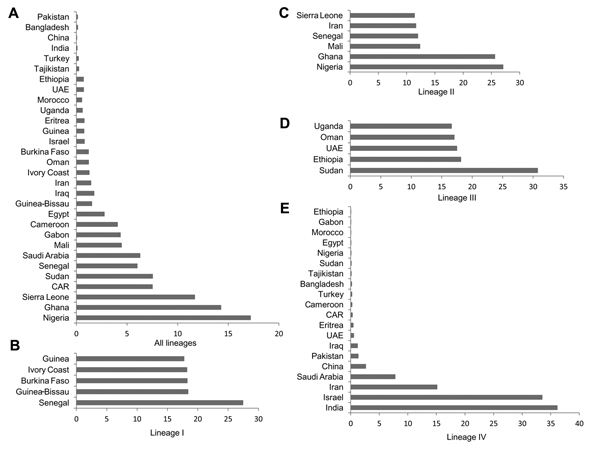Molecular Evolution of Peste des Petits Ruminants Virus
Murali Muniraju, Muhammad Munir, AravindhBabu R. Parthiban, Ashley Banyard, Jingyue Bao, Zhiliang Wang, Chrisostom Ayebazibwe, Gelagay Ayelet, Mehdi El Harrak, Mana Mahapatra, Geneviève Libeau, Carrie Batten, and Satya Parida

Author affiliations: The Pirbright Institute, Pirbright, UK (M. Muniraju, M. Munir, M. Mahapatra, C. Batten, S. Parida); National Institute for Animal Biotechnology, Hyderabad, India (A.R. Parthiban, S Parida); Animal Health and Veterinary Laboratories Agency, Weybridge, UK (A.C. Banyard); China Animal Health and Epidemiology Centre, Qingdao, China (J. Bao, Z. Wang); National Animal Disease Diagnostics and Epidemiology Centre, Entebbe, Uganda (C. Ayebazibwe); National Veterinary Institute, Debre Zeit, Ethiopia (G. Ayelet); Société de Productions Pharmaceutiques et Vétérinaires, Rabat, Morocco (M. El Harrak); Le Centre de Cooperation Internationale en Recherche Agronomique pour le Développement, Montpellier (G. Libeau)
Main Article
Figure 6

Figure 6. Probability of root locations of the most recent common ancestral peste des petits ruminants (PPRV). MCC trees were obtained by using the continuous time Markov chain and Bayesian stochastic search variable selection procedures. Root location probabilities of the most recent common ancestor using global PPRV isolates (panel A ) are shown graphically alongside lineages I–IV (panels B–E) and were estimated by using a complete dataset of PPRV partial nucleoprotein gene data and individual lineages separately. Probabilities of root locations are shown as percentages along the x-axes. UAE, United Arab Emirates; CAR, Central African Republic.
Main Article
Page created: November 18, 2014
Page updated: November 18, 2014
Page reviewed: November 18, 2014
The conclusions, findings, and opinions expressed by authors contributing to this journal do not necessarily reflect the official position of the U.S. Department of Health and Human Services, the Public Health Service, the Centers for Disease Control and Prevention, or the authors' affiliated institutions. Use of trade names is for identification only and does not imply endorsement by any of the groups named above.
